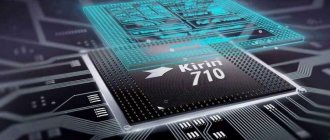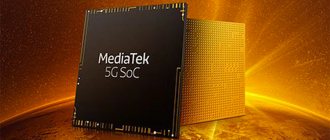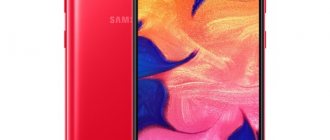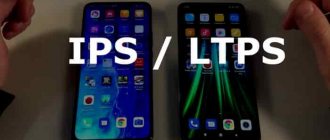Everyone who chose a smartphone thought about what they needed to get from their future gadget.
Some opted for budget options, while others chose flagships without paying attention to technical specifications. But most people know exactly which smartphone they need and for what purposes. The main element of the phone's “stuffing”, which is looked at first, is the processor. It determines the time, speed and smoothness of the device, as well as performance in resource-intensive games and applications. Each processor has basic parameters.
Features of the manufacturer's developments
According to Korneychuk, each manufacturer has its own shells for Android and iOS devices. “Different versions of shells can work in their own way, that is, it’s good for one manufacturer with such hardware and such an operating system, and bad for another. Each company has its own characteristics,” says Korneychuk.
Processor cores, RAM or OS? How to choose the fastest smartphone
What is System On A Chip (SoC)?
If we are talking about mobile processors, we first need to clearly understand what exactly we mean by the term processor. In desktop computers and laptops, the processor refers to the central processing unit, the element that powers the computer's computing capabilities.
In the mobile world, a processor usually means a System on a Chip, or SoC. This is one small chip, roughly the size of a computer processor, which contains most of the components necessary for the device to function.
The SoC includes a CPU (computing cores), a GPU (graphics accelerator, which in computers is usually allocated as a separate card), various radio modules and sensors, such as Wifi, GSM modem, Bluetooth, GPS and others. It is the SoC that determines the capabilities that the device will support, for example, the maximum resolution at which the camera can shoot or support and playback of 4K video.
The main advantages of using an SoC instead of individual components are its small size, low power consumption and lower heat dissipation. The Apple A8, Qualcomm Snapdragon 810 and Samsung Exynos are all examples of System on a Chip, but very often they are described as the processors of the device.
Number of processor cores
It is generally accepted that the more cores a smartphone processor has, the more powerful it is. This is not entirely true. And not in all cases. If we are talking about dual-core chips, then everything will be bad. Quad- and eight-core processors have a completely different filling. It turns out that modern eight-core chips are actually two quad-core processors that share different tasks between them. That is, two sets of four cores are used, one of which has a lower clock speed. “There are big little and big middle little concepts, according to which the processor design scheme was developed. In this set, processor cores are combined and have different performance: some cores are very fast, some are average, and some are slow,” the expert explained to AiF.ru.
Next material
The most interesting things on social networks
In this article, the story will not be about the appearance of the devices and ease of use, nor about how the keys and elements on the case should be located. Here I will try to tell you how to choose a smartphone or tablet based on the filling - processor, memory, graphics core.
The Android operating system is so popular that devices running it are produced not only by famous manufacturers, but also by many little-known companies. Fewer companies produce processors for devices running Android, but there are a huge number of chips - single-core, dual-core, quad-core and even eight-core. Smartphones and tablets, among other things, have different amounts of memory from 256 megabytes to 3 gigabytes, and, most importantly for Android games, different graphics processors.
Let's look at a few famous claims:
More memory - faster Android
If we are talking about RAM, then this is true, because the larger the amount of memory, the less the Android operating system needs to access the internal storage, the speed of which is several times lower than the speed of RAM.
More cores - faster Android
If we are talking about identical chips with different numbers of cores, then yes, the more cores, the faster the system. But! If we are talking about different chips from different manufacturers, then the number of processor cores for Android does not play a decisive role . For example, my dual-core SONY Xperia SP smartphone is noticeably faster in performance than some quad-core devices.
8 cores are faster than 4
As for 8-core processors, in reality there are few of them. And many eight-core processors are actually two quad-core processors running separately. One more powerful one turns on under heavy load - for example, games, watching videos, heavy applications, and the second one works for light tasks. This scheme is needed to increase the battery life of Android devices.
More processor frequency - faster Android
Here the situation is the same as in point 2. If this is a processor of the same series, from the same manufacturer, then an increase in frequency leads to an increase in the speed of the Android device. But processors, for example MediaTek and Qualcomm, at the same frequency can show different results.
The newer the Android version, the better.
With each new version, Android becomes more functional, additional features and capabilities appear. But the programmers of the Android project, without a doubt, not only add functionality, but also improve and optimize the kernel of the Android operating system. Therefore, yes, the newer the Android version, the better.
My SONY Xperia SP initially had Android 4.1, then it was updated to version 4.3 and the phone began to work noticeably faster, and rare interface lags disappeared. It’s just a pity that the Android 4.4 update will not be released for the Xperia SP, more details here.
What else is important for performance?
Ads for Android phones and tablets usually focus on the amount of memory and the number of processor cores, but rarely mention the graphics processor. Namely, the performance of an Android phone or tablet in games depends on the graphics chip.
Which processor to choose for a smartphone?
Often, smartphone buyers are faced with the question: which processor is better to choose for their phone. Many people believe that the number of cores and frequency play a key role in the selection. But this factor is not decisive in the performance and performance of a mobile device.
What determines the performance of smartphones?
The performance indicators of gadgets depend on the following factors:
- random access memory;
- processor type;
- type of graphics adapter.
These factors determine the smooth launch of the interface and the successful start of various applications. Therefore, before you buy a mobile device, you should find out which processor is best for your smartphone so that it functions as efficiently as possible.
Platforms for mobile devices
The most popular mobile phone platforms are:
- Windows Phone;
- Android;
- iOS for iPhone.
The speed of the smartphone and the ability to quickly open applications will depend on the amount of RAM.
Processor manufacturers
What are the best processors for smartphones? There is no clear answer to this question. It is worth noting one of the leaders in the production of microchips. This is the Qualcomm company, which developed such bestsellers as Snapdragon 400, 600 and 800. Apple Corporation designs processors independently for its devices using ARM architecture. The Korean brand Samsung has also developed Samsung Exynos microchips, which are installed on the company's TOP smartphones. The Chinese company MediaTek, which is confidently mastering the modern market, is also worthy of special attention. It is worth mentioning the Intel brand, which produces processors based on the x86 architecture, used for the development of computer microchips. The products of this manufacturer are mainly used in Windows devices.
Processor frequency: which is better for a smartphone?
When choosing a smartphone, you should not focus on clock speeds. But the higher the numbers, the better it is. Almost all processors for mobile phones have the ability to automatically adjust their own frequencies. Therefore, the characteristics of a smartphone or tablet indicate the upper figure. The bulk of smartphones have processors with the following ranges:
- 1000-1300 MHz for budget models;
- 1300-1700 MHz for the middle class;
- 1900 MHz is the most powerful processor for a smartphone or tablet.
It is important to understand: megahertz on one device can “show themselves” faster than on another. The performance speed of a gadget is influenced not only by frequency, but also by many other parameters. To determine the speed of the processor, special programs have been developed that can be used to compare the performance of smartphones. Under any circumstances, it is better to choose a processor for a smartphone with a microchip with a frequency of at least 1500 MHz.
How many cores are needed for the device to function effectively?
On the modern market there is a huge number of multi-core processors that use several computing units for different tasks. After the creation of dual-core microchips, four-, five- and eight-core solutions also began to appear on the market. When buying a mobile device, the choice may seem obvious, based on the principle - the more cores, the better. But it is not always the case. Smartphone processors almost never use all cores to launch and operate applications, for most of which a dual-core chip is sufficient. A clear indication of this is the latest version of the iPhone, which uses a dual-core processor. Correct and high-quality optimization allows the gadget to function at the highest level, and the performance of this device will be the envy of many devices, even with eight-core microchips.
It is worth paying attention to the Samsung Exynos 5 processor, which is equipped with some models of the brand’s gadgets. It has eight cores thanks to two quad-core microchips that do not function simultaneously. One of the processors is more powerful and starts when opening “heavy” games and applications. At the same time, he is quite “voracious”. The rest of the tasks are performed by a more energy-efficient chip, which conserves battery power and is capable of delivering excellent performance for less complex applications.
Don't know how to choose a good processor for your smartphone? When purchasing a budget device, a dual-core chip will be enough. If you are passionate about games, you should pay attention to quad-core variations. An eight-core processor is, of course, good, but there is practically no use for it yet. When it becomes possible to use such gadgets, modern premium smartphones will cost the same as budget models.
Which processor is better for an Android smartphone?
Most Android devices are powered by Snapdragon microchips manufactured by Qualcomm. With a sufficiently significant load, the gadget will work at full power, which is indicated in its characteristics. And when idle, operating frequencies will be reduced to save battery.
It would be wrong to say that Snapdragon is the best processor for an Android smartphone. But the popularity of installing it on most devices is quite high.
Which phone to buy so that it is fast
After reading everything above, many may have a question about which phone or tablet to buy so that it is fast enough. Perhaps one of the readers is planning to change their phone and wants to know how much faster the new phone will be than the old one.
Testing the phone
Download a special test called Antutu Benchmark to determine how powerful a phone is. It checks the operating speed of each smartphone component and, based on the test results, gives the Android device a final score.
Just compare this score for different phones and find out which one is more powerful, and approximately how much more powerful. In addition to assessing the power of the phone, in the Antutu Benchmark application you can see detailed information about the device - processor model, graphics core model, screen resolution, installed sensors and much more.
The better the processor, the better the photos.
It's no secret that the quality of photography depends not only on the sensor, lenses and software, but also on the power of the processor and image processing unit. Let's remember Google Pixel 4, this smartphone has only one camera, but due to the flagship processor and Google's proprietary photo processor, the quality of photos is still head and shoulders above that of many smartphones.
The latest Huawei smartphones (Mate 30 Pro, P40 Pro) running on Kirin 990 processors are the best photo flagships due to the modified ISP unit, which has improved noise reduction in photos and videos. This was made possible thanks to 3D filtering technology (BM3D), usually used in digital cameras, based on this it becomes clear why Huawei flagships are better in terms of photography than all competitors.
What affects the operating time of a smartphone?
Remember the good old days when you only charged your mobile phone battery once every three days? This doesn't happen today. The Washington Post studied 13 smartphones and tested the quality of their batteries to answer the main question - whether they live up to the manufacturers' promises.
It was found that manufacturers' guarantees regarding a full day of operation on a single charge for smartphones such as the iPhone XR and Samsung Note 9 were not met - the batteries could only last 12 hours in video playback mode.
Display size has a significant impact on battery life. Due to the large display area, the smartphone requires more power, especially at high brightness. Additionally, there are millions of apps that can consume a lot of battery power without you even noticing it. In addition, the power consumption is greatly influenced by the smartphone's hardware - Snapdragon processors from the mid-range and top-end lines are considered the most energy-efficient.
System on a chip is the heart of your smartphone
Such a scheme for combining important components on one printed circuit board significantly helps to reduce the cost of smartphone production, and also contributes to better power consumption. The processor (SoC) is subsequently connected to the remaining components of the smartphone.
I will give a small list of modules that are installed in the system on a chip.
- The central processing unit (CPU) is
the “heart” of the SoC. Executes basic instructions and algorithms of the operating system and applications - Graphics Processing Unit (GPU) - Performs graphics-related tasks, rendering the operating system graphical shell, user interface in applications, and processes 2D and 3D graphics.
- Image processing unit (ISP) - converts data received from the smartphone camera into photos and videos.
- Digital Signal Processor (DSP) - Performs more complex mathematical functions than a central processing unit. Unpacks music files and analyzes gyroscope sensor data.
- Neural Processing Unit (NPU) is a widely used module used in mid- and high-end smartphones. Used for hardware acceleration of neural network algorithms, computer vision, voice recognition, machine learning and other artificial intelligence methods.
- Video encoder/decoder - Provides energy-efficient conversion of video files and formats.
- Modems - Converts wireless signals into data that your phone can understand. Components include cellular, WiFi and Bluetooth modems.
It is also important to know that a system on a chip, like any other chip, is produced according to a specific technical process. A technical process is a technological process for manufacturing semiconductor materials. Improvements in technology make it possible to improve the characteristics of semiconductors (size, power consumption, operating frequencies, cost).
Today, mobile processors built on the ARM architecture are made using a 7-nm process technology, but the production of semiconductors using a 5-nm process technology is already underway.
iPhone and Android: battery differences
Different manufacturers use different batteries in smartphones. While all Android brands specify how much capacity a smartphone's battery has, Apple describes battery performance in terms of talk time. In fact, the battery of the new iPhones is relatively small - up to 3500 mAh in the top version of the iPhone 11 Pro Max.
Article continues after advertisement
The company continues to try to remain a leader in the development of good displays, cameras and other add-ons, the operation of which, however, is accompanied by a high level of power consumption. And Apple fans have been making a compromise for many years now: to get a thin, practical and modern smartphone, they have to give up a large battery.
Android users can benefit more from battery life. Many of the models offer both a large battery and a good display. Most Android smartphones are much larger and thicker than thin iPhones, precisely because manufacturers use larger batteries.
Who makes mobile processors
Today, the main manufacturer of mobile processors is Qualcomm. Next come Mediatek and Samsung, as well as Huawei, which will soon stop developing and producing proprietary Kirin processors due to US sanctions.
So, Qualcomm produces mobile processors for flagships, mid-range and budget smartphones. The flagship processors are the Snapdragon 8xx line. Mid-segment processors are included in the 600 and 700 series. Some of these chips may have a postfix with 5G or with the letter “G”, the first designation means support for fifth-generation networks, the letter “G” in the name of the chip means that it is designed for games. Entry-level processors belong to the 400 series.
Samsung also produces chipsets for various segments. The flagship series belongs to the 900 series, the latest processor is Exynos 990, it is installed in the Galaxy S20/Note 20. Budget smartphones are equipped with processors numbered Exynos 7904 and Exynos 9610
In addition to the above processors, there are chips from the well-known company Mediatek. Their solutions can most often be found in budget and mid-budget smartphones, for example in OPPO Reno 3. Mediatek produces platforms called Helio, there is a main “P” line, a line aimed at games under the “G” index, and more recently processors under the name Dimensity with 5G support.
How to increase the operating time of your smartphone
The process of choosing the perfect phone can take some time. Comparing battery capacity, performance, camera specs, display and most of all additional features can distract you from the really important factor - the battery.
- Buying a phone with maximum parameters and a small battery, unfortunately, cannot be compensated by installing energy-saving applications.
- If you don't use your smartphone all day, chances are its battery will last even longer than a day.
- Dimming the screen brightness or turning off background programs can also improve battery life.
How to read processor characteristics?
And so, you look at the characteristics of the device. iPhone X processor specifications include the following:
- Apple A11 Bionic;
- Hexa-core 2.39 GHz (2x Monsoon + 4x Mistral) x64;
- Apple GPU.
Here we can see that the SoC is Apple A11, a six-core (Hexa-core) computing processor with a frequency of 2.39 GHz. Bionic is the name of this processor from Apple. The processor is 64-bit and runs on ARM v8 architecture. Apple's own solution is used as a graphics accelerator. Particular attention should be paid to the kernels. The number of cores is written as 4+2, four energy-saving and two powerful for complex tasks.
The specifications of OnePlus 6 are as follows:
- Qualcomm Snapdragon 845;
- Octa-core (4×2.8 GHz Kryo 385 Gold & 4×1.7 GHz);
- Kryo 385 Silver;
- Adreno 630.
OnePlus uses Qualcomm's SoC - Snapdragon 845. Here, 845 is the version of the SoC model. At the beginning of 2022, the top model. The computing processor is eight-core, with a frequency of 2.8 GHz. Here, too, all the cores are divided into two clusters - four highly efficient ones with a frequency of 2.8 GHz and four energy-saving ones with a frequency of 1.7 GHz. There are two more cores than the iPhone, and the frequency is also higher. It seems that it is more powerful, but later we will see that this is not always the case. Kryo 385 Silver is the name of the computing processor, it is also built on ARM architecture. The graphics accelerator is Adreno 630.
Smartphone processor
h21,0,0,0,0—>
The processor in a smartphone, just like in any other more or less complex electronic device, is its most important component. Depending on how powerful it is, the speed of the device is largely determined.
p, blockquote4,0,0,0,0—>
Processor performance is measured in Hertz. Hertz is the clock frequency. The times when productivity was measured in Hertz have already passed decades ago, and the power of modern “stones” is already measured in Mega Hertz, and more often in Giga Hertz. Everything here is extremely simple - the higher this indicator, the more productive the CPU.
p, blockquote5,1,0,0,0—>
The number of cores is also of particular importance. If the processor is dual-core or quad-core, then it can work with two or four threads simultaneously, which increases performance by an order of magnitude.
p, blockquote6,0,0,0,0—> p, blockquote7,0,0,1,0—>
explanation for dummies - MirDostupa
Let's find out how processor frequency affects speed in applications, videos and games...
Smartphone advertising can be confusing - it contains various technical characteristics of a mobile device that remain incomprehensible to most users.
Today we will also answer the question of what the processor frequency in a smartphone affects.
In advertising you can hear a variety of technical information, which, with a high degree of probability, will not say anything to the average user. Quad-core processor, 128Gb SSD, 4 Gb RAM, 2.1 GHz - when an untrained user encounters such designations, at best, he will try to Google them
All of the above symbols indicate the technical characteristics of the smartphone. Let's look at all the listed parameters in order - let's start with the processor.
What is a quad core processor? The number of cores is a parameter that describes how many threads a processor can simultaneously perform computational operations.
We will answer the question of what the processor in a smartphone influences further, but first, let’s look at the basic designations of the technical characteristics of a smartphone.
- 128 Gb SSD - this parameter indicates the capacity of permanent memory;
- 4Gb RAM - the indicator indicates the capacity of the RAM;
- 2.1 GHz - this characteristic indicates the power of the processor and indicates its clock frequency.
It is quite simple to answer the question of what the processor frequency in a smartphone affects, but only if you know exactly what this indicator means.
Processor frequency is an indicator of the number of operations performed by the processor per unit of time. Pulses are applied to one of the processor outputs, with each of which it performs an elementary action, for example, register-register operations
Executing any program on a smartphone, as well as on a computer, is a chain of similar actions. The higher the processor clock speed, the faster it processes the program.
It should be noted that the number of cores does not increase the performance of a mobile device, but affects its power
Let's make a clear analogy: let's say four cars are driving along a highway at a speed of 40 km/h - this does not mean that the total speed of all cars is 160 km/h, but these cars will be able to transfer 4 times more cargo at the same time.
It would take a long time to describe what the processor frequency in a smartphone affects, but the most effective thing to do from the very beginning is to correlate your budget with the necessary characteristics that are required for a new device...
Smartphone RAM
h22,0,0,0,0—> p, blockquote8,0,0,0,0—>
You cannot experience the full power of the processor if you do not have the proper amount of RAM installed.
. When a program starts, some of its data is sent to RAM. From there the processor retrieves them and processes them.
p, blockquote9,0,0,0,0—> p, blockquote10,0,0,0,1—>
If there is not enough RAM, the smartphone begins to think for a long time, and ultimately may freeze altogether, even if the processor has a high frequency and, for example, four cores.
after—>
If you are going to purchase a modern and high-quality smartphone, then you will inevitably come across a description of its characteristics. Many may find it unclear which characteristics of a smartphone are important and what they affect. Here is a breakdown of the main and most important ones.
What are the cores in the processor for?
The core is the most important element of the central processor. It is a part of the processor that can execute one thread of instructions. The cores differ in cache memory size, bus frequency, manufacturing technology, etc. ... At the moment, processors with 2, 3, 4 and 6 cores are widely available.
Interesting materials:
How to view deleted WhatsApp chats? How to view a street from a satellite? How to see all open tabs? How to see all tags on Instagram? How to see all Google search queries? How to view your entire browsing history in Odnoklassniki? How can I see the whole story? How to place 8 queens? How to put Alice on the taskbar? How to put Alice on your desktop?
Screen diagonal
The most expensive part of any modern phone is the display. The larger its diagonal, the more convenient it will be to use the Internet and other functions. Most modern smartphones have screen diagonals ranging from 4 to 6 inches. This allows you to use your phone for:
- surfing the Internet through a browser or other applications;
- working with email;
- viewing videos and photos;
- creating and editing documents.
A larger screen makes it easier to use the keyboard and work with applications. Nevertheless, there are people who find it inconvenient to use a large smartphone in everyday life - it cannot be put in a pocket, it is inconvenient when talking. The choice of screen diagonal should be made based on your preferences. If you often work with the Internet, then you should choose a diagonal of 5 inches or higher; for a simple dialer, 4-5 inches is enough.
Remember, the larger the screen diagonal of a smartphone, the higher the battery capacity should be. If you put a five-inch display on a device with a weak battery, the battery will quickly drain while playing games or watching videos. You will have to constantly look for an outlet or carry an external battery with you.
Screen resolution, DPI
The next point in the characteristics of a smartphone that you need to know about the display is its resolution and matrix type. With the same screen diagonal, its resolution may be different. The higher it is, the better. Resolution affects image quality and detail. The following options are currently popular:
- HD Ready – 1280x720;
- Full HD – 1920×1080.
In some cases, the number of pixels is represented by the DPI (density per inch) parameter. The higher this parameter is, the better the image will be. The calculation of this density is directly related to the screen resolution. For example, for FullHD DPI is given from 400 to 440 pixels.
Budget smartphones with large screens have lower resolution, which makes the picture lower quality. If you often use your smartphone to read email or watch videos, then it is better to choose a screen with a high resolution and dot density. You will be less tired when using your phone.
By matrix type, the leaders now are smartphones with Amoled and IPS displays. In the first case, color rendition will be more realistic and deep. Budget smartphones often have IPS matrices; they are sufficient for working with instant messengers and social networks. But the quality of video or graphics in games may seem insufficient to you.
Internal memory, ROM
ROM (ROM) or permanent (internal) memory is the parameter that is most important in the modern world. Smartphone users constantly need to use more and more applications. Just 7 years ago, users installed a couple of games and social networking applications on their devices. They didn't need anything else. Now many banks, online stores and other services have released applications that make life easier for anyone.
Using a smartphone, you can pay for utilities, monitor the status of bank accounts, receive government services, read news, communicate, track parcels and discount promotions in stores. And this is not a complete list of the capabilities of a small phone. The more applications you need in everyday life, the more internal memory your smartphone needs, because most utilities are installed there.
In addition, modern applications have become more demanding on the amount of free memory. Just 5 years ago, the average size of an installed application was 30-40 MB; now utilities occupy from 100 to 300 MB in the internal memory. Experts recommend purchasing smartphones with internal memory of at least 8-16 GB. In this case, you should immediately pay attention to whether the device has a slot for a memory card. If it is missing, then the ROM volume should be larger from 32 to 128 GB.
RAM
RAM (random access memory) is responsible for the speed of the smartphone. Just like on a computer, applications use RAM rather than the hard drive when running. It allows you to play games, work with applications and surf the Internet. This parameter affects the cost and class of the phone.
The minimum for a modern smartphone is 1 GB of RAM. This is sufficient for most applications to function. But it is better if there is more RAM so that you can watch movies and play games with good graphics. In this case, the choice will depend only on how you will use the smartphone: make calls and do banking transactions - 1 GB, play, run several applications and watch videos - from 2 or more GB.
Availability of memory slot
modojo.com
If previously only Apple equipment had only built-in memory, without the ability to expand it, now other manufacturers have begun to make devices without a card slot. This is not very convenient for the average user. You have to connect your smartphone to your computer to upload photos, although this can only be done using a card reader.
When choosing a device with a memory card slot, you need to pay attention to the permissible class of the flash drive. The higher it is, the faster the files will be saved. The size of the flash card should be selected based on how much you like to take photographs or store other files on your phone. The optimal flash card size is 32 GB; it is best if it supports class 10 memory with the highest write speed.
Number of SIM cards
phonecorridor.com
Another criterion for choosing a modern smartphone is the number of slots for SIM cards. If you only use one phone number, then there is no point in chasing a smartphone with a large number of slots. For those who have a work contact and a number for personal needs, it makes sense to take a device with two or more slots.
A multi-SIM phone allows you to save on communication costs by making calls to subscribers of different operators from a separate number. Many cellular companies give you the right to make calls within the network without paying, you can take advantage of this by purchasing a smartphone with 2 or 3 slots. Just keep in mind that when using one SIM card, the rest will be outside the network, since there is only one radio module in any smartphone.
What wireless standards does it support?
Almost every smartphone has a full range of wireless communications on board, because this is its direct purpose - to connect to networks so that you can make calls and use the Internet. Modern smartphones support the following communication standards:
- LTE is the most modern and fastest connection, the most common in Russia is the 2600 MHz band, but some operators also support others: 1800 or 800 MHz;
- 3G (UMTS) – allows you to transfer data at speeds of tens of MB per second;
- GSM is a standard common wherever there is cellular communication; it allows you to make voice calls and send SMS;
- GPRS is a public radio communication that allows you to get mobile Internet access at the lowest speed.
Modern smartphones all support GSM, GPRS, 3G standards. It is best to purchase a device that can also connect to LTE, since this standard is appearing almost everywhere. LTE networks have already appeared in many large and small cities. Before purchasing a smartphone, check what range your operator operates in. There is no point in saving on this parameter, since very soon 3G will become obsolete, just as GPRS once faded into the background. LTE and 5G networks will be widespread.
All smartphones are equipped with a Wi-Fi module. It also works with different standards. They are indicated as a letter located at the end of the module version. Connection types are: a, b, c, g, n, ac. The network detection radius and the speed of operation in it depend on the type of connection. Type A has the most limited parameters; to work with Wi-Fi you need to be almost close to the access point. When choosing a smartphone, it is best to focus on a universal type n module or the fastest ac. This will allow you to connect to public networks, and not only work with Wi-Fi at home.
Battery capacity
Doogee X5 Max Pro battery
The battery in a smartphone can be removable or stationary. In the latter case, the devices are thinner and lighter. But the most important thing is not the type of battery, but its capacity. You should choose a smartphone based on this parameter based on the screen diagonal. The larger the display, the higher the battery capacity should be.
If you don't want to buy a portable charger or constantly search for a charging outlet, then you need to choose a battery with a high capacity. For modern models that constantly use the Internet, 2000 mAh is not enough. This capacity is suitable for a phone from which you will only make calls.
For a model with a screen larger than 5 inches, the best battery capacity will be 2500 mAh and above. If your device supports LTE and is actively used, then it will hold a charge longer with a battery capacity of over 3000 mAh.
Year of manufacture and brand
Most experts recommend starting when choosing a smartphone with the manufacturer. The unchanged leaders over the past 5 years have remained:
- Apple;
- Samsung;
- Lenovo;
- HTC;
- Sony.
In the last two years, these manufacturers have been slightly squeezed out by Chinese developers: Xiaomi and Meizu, Huawei. They produce reliable and competitive equipment that combines what consumers need - good performance, high build quality and an affordable price. At the same time, the development of Chinese brands has set a new trend - it is better to choose a smartphone not by the name of the manufacturer, but by its characteristics.
As for the year of manufacture, it is best to take “newer” equipment, as it becomes outdated very quickly. In 2018 smartphones, almost all have additional features such as NFS (payment technology), LTE.
Operating system and versions
9to5google.com
After manufacturers decided to expand the functionality of smartphones, which became possible after using operating systems in them. Now you can find devices running one of the OS:
- IOS;
- Android;
- Windows Mobile.
You should choose according to your taste and wallet. iOS is used only in Apple devices, which are distinguished by their high cost. This system is praised for its high security, speed and convenience.
The Android system is the most democratic; most smartphones are released with it. Its advantage is that it is possible to make a proprietary shell for the manufacturer or telecom operator. There are also many free applications available for this system.
WindowsMobile has fewer fans. This system is convenient for those who use their smartphone almost like a computer. It has all the necessary functions to work with office applications. But still, the number of programs available for download is very small; users have no choice of what to use in certain cases.
As for the operating system version, it is better to purchase a newer version. This will allow you to enjoy all the functions of the device, and not have to worry about updating it in the coming years. Moreover, applications are created based on the latest versions of the OS.
GPS
In recent years, many applications use GPS satellite navigation. The main purpose of this technology is to help a person navigate the terrain. Cunning marketers began to use GPS for their own purposes - they determine the location of a person in order to target him with advertisements for establishments or services.
Every smartphone has GPS, but not everyone supports A-GPS geolocation technology. The latter is best suited for using navigation in the city, as it requires not only communication with satellites, but also a constant connection to the Internet to clarify coordinates. If you plan to use fitness apps or pedometers or get directions in the city, then it’s worth investing in a smartphone with A-GPS.
Processor, cores, frequency, CPU
More than 60% of users believe that a good smartphone should work quickly. In addition to RAM, high operating speed is ensured by the number of processor cores and their frequency. First of all, you should pay attention to the number of cores - there are models. In which there are 1,2,4,8 or 16 of them.
The optimal number of cores for a budget smartphone is at least 2. If you want to run games on your device or watch online videos, then it is better to have 8 or 16 of them. The clock speed of the cores determines how many commands the smartphone can execute per second. The higher it is, the better.
Why does a smartphone need a powerful processor? | Blog
There is an opinion that modern budget smartphones, or at least some of them, cope well with almost all tasks, guaranteeing high performance. And there is supposedly no point in overpaying for a device with a powerful processor. But how true is this statement? What can a flagship smartphone do that a budget smartphone can’t?
In order to answer these questions, you will need to not only understand what use cases are available for modern mobile devices, but also what components the chipsets consist of.
What are modern mobile processors?
Although smartphones these days allow you to run games, read and edit documents, and do a lot of other operations, but unlike the computer system unit, in which the user can replace any components, in smartphones and tablets everything is built around the processor and is integral to it part.
In essence, a mobile processor is a single-chip system that already contains a video chip, as well as various modules and sensors. The set of functions can be partially influenced by the manufacturer, who, for example, has the right to add additional sensors or increase the amount of RAM and internal memory. But the user will have to put up with what is inside the smartphone, and will have to forget about the possibility of an upgrade.
The production of mobile processors is designed in such a way that new chip models are released every year, but the average user does not always see the difference, for example, between the current flagship processor and the model that was the most powerful and technologically advanced in the previous generation. But once you look into the issue in more detail, it turns out that there is a difference in literally everything.
Which processors are powerful?
As it seems at first, everything here is extremely simple - the more cores and the higher their frequency, the more powerful the processor and the more opportunities it provides to the user. If you focus only on these numbers, it may seem that some smartphones are even more powerful than some PCs. However, much depends on the architecture of the cores, as well as on the graphics, which are an integral part of the single-chip system along with the processor.
For example, currently popular processors in the budget segment with only Cortex-A53 cores will be inferior in performance to analogues with Cortex-A75 or, especially, A76 cores, even if it turns out that the frequency of the latter will be lower. But there are pitfalls here too. Let's compare the popular budget chips MediaTek Helio P22 and Snapdragon 439. The chip from MTK has the same cores as the product from the American company Qualcomm, but the frequency is slightly higher for the Chinese processor. It seems that the Helio P22 is preferable, especially since it sometimes gives higher scores in popular synthetic performance tests (for example, in Antutu), but when you launch any game, you immediately feel that the Snapdragon 439 behaves much better and more stable in terms of drawdowns frames. Why does this happen? But because sometimes it is more important which video chip is used in conjunction with the processor. There is an opinion that games and some applications are much better optimized for Adreno graphics used by Qualcomm than for Mali.
One should not draw hasty conclusions from this, since in flagship smartphones the same Mali copes well with any games, and in all cases it is necessary to consider certain models of processors, or, more precisely, single-chip systems.
games and applications
Modern heavy games tend to develop graphically, and in addition, in their settings you can find several items that allow you to select one or another graphics level. Over time, new modes with improved graphics may appear, and on not very powerful mobile devices, new versions of games and applications may simply begin to slow down due to too low frames per second. Some games do not run at all on smartphones and tablets with budget processors. Therefore, it is important that the device has the most powerful hardware possible, which could guarantee the absence of various problems with running software for several years.
Popular synthetic performance tests also do not stand still - their developers are constantly either releasing new versions of software or supplementing existing applications with complex graphics tests. The reason for this behavior is trivial - old benchmarks are not able to fully load new powerful devices constantly appearing on the market, and this also indicates the development of mobile processors. The size of applications is also increasing - software takes up more and more space in the device’s memory, and for budget processors this can become a serious burden.
Fast work
It is powerful multi-core processors with plenty of RAM that make modern devices truly multitasking. The user simply no longer needs to limit himself in any way - he can run a heavy game while simultaneously recording the screen, and if necessary, for example, even minimize the youtube application altogether by placing a small window with a video somewhere in the corner of the screen .
But if we start from more realistic and popular tasks in everyday life, then in the Internet browser you will be able to open many tabs, and in the background you will be able to hold many applications, instantly switching between them. This will be in demand for those users who use a large number of instant messengers, but it is also relevant for other software.
High-quality photos and videos
When it comes to mobile devices, and not only about them, most users are convinced that the more megapixels in the camera, the better the final result. In some cases this does provide excellent detail, but this is not always the case. And it is not at all surprising that even in the flagships of 2022, although there is a shooting mode, for example, in a resolution of 40 megapixels, the manufacturer recommends setting the settings to 16, 13 or even 10 megapixels. And, indeed, not on all smartphones you can feel the difference between 40 and 10 MP photos.
The thing is that now the number of megapixels is not so important (although there are exceptions), especially in the case of compact camera modules, which have certain limitations compared to specialized equipment. In this case, post-processing of photographs comes to the fore, and for high-quality photographs you need not only good software, but also a powerful processor that can create a good frame as quickly as possible. Also, powerful hardware, which must work in conjunction with fast memory, will be needed for the camera to support a large number of modes, including high-quality night photography and video recording with 4K resolution at 60 frames per second.
As a rule, it is a single-chip system with a powerful processor and other high-quality components that provides excellent navigation quality. This is expressed in the fact that modern powerful smartphones, compared to their budget counterparts, can not only work with all types of navigation systems (and this, in addition to GPS and GLONASS, also BEIDOU, GALILEO and QZSS), but also see a larger number of satellites under the same conditions.
Hardware also affects the speed of the so-called “cold start,” when a smartphone finds itself without the Internet and access to various networks in a place where it has never been before, and it is faced with the task of determining the location only from satellites.
The quality of communication and Internet speed also depend on the components of a single-chip system, and with the development of technology, wireless modules can receive new standards and codecs, so powerful processors even affect sound quality.
Screen resolution
Powerful processors allow smartphones to use displays with FullHD resolution and higher, while budget devices often have a maximum resolution of HD+ (1600x720 and lower). The number of pixels directly affects image quality, although displays have many other criteria that are important for getting a good picture. There is an opinion that FullHD resolution is more than enough for any smartphone, but given that mobile devices in the future will probably increasingly be used to immerse themselves in the world of virtual reality, and this involves keeping the smartphone close to the eyes, then in this case the higher the screen resolution, all the better. At the same time, modern devices allow the user to choose the screen resolution themselves, so there is no need to be afraid of the device’s lifespan from a single charge being too shortened.
Energy efficiency
The most energy-efficient solutions first go to smartphones with new powerful processors, and only then, after some time, we can hope for their appearance in the budget segment. The technical process plays a major role in ensuring energy efficiency, and at the end of 2022, flagship processors are 7 nm in size, which significantly reduces their area and has a positive effect on reducing energy consumption. On the other hand, chips are becoming more and more powerful, but due to the presence of energy-efficient cores, smartphones can work for quite a long time even at maximum load.
Results
Regardless of use cases, smartphones undoubtedly need powerful processors. Thanks to them, an ordinary push-button telephone was able to evolve into a truly multimedia device, which, although it cannot completely replace a computer, game console, camera and other devices, makes the user as mobile as possible, allowing him to keep a device in his pocket that can, or otherwise, solve many problems. Moreover, usually the more powerful the smartphone or tablet, the faster and better you can achieve your goals - flagship solutions affect both the speed of the Internet and the quality of navigation and all other functions. And the idea that a powerful chip is needed only for those who like to play games must be relegated to the category of myths.
Graphics Processing Unit, GPU
You can save on this option if you do not want to run modern games or videos with FullHD quality on your device. In other cases, you should choose models with. The GPU clock frequency must be at least 200 MHz, the higher it is, the better. For a device that will perform the simplest functions, a frequency of 128 MHz is sufficient.
Cameras
Almost all smartphones are equipped with two cameras – front and main. The first is necessary for making video calls and selfies. If you don’t often have video calls or don’t like to take photographs, then you can save money on a camera - it can be only 1-2 megapixels.
The main camera (aka the rear one) is used more actively, so it should have at least 8 megapixels. This is enough to take photos of documents (they are now replacing scanned copies everywhere), scan QR codes, or simply capture important moments.
What is the best inexpensive smartphone with a good camera to buy in 2019?
Almost every modern person sometimes has to shoot a video. If you plan to watch videos on a big screen or post them on the Internet, then you should choose a camera with FullHD support. For those who vlog or often shoot videos, a smartphone with 4K resolution will be of interest. It is worth noting that this resolution is only available in premium devices that have a lot of additional functions and top-end specifications.
What should be the characteristics of a smartphone?
For the most part, choosing a smartphone is a matter of taste and needs. For some, it is enough to have the simplest model, which only supports calls, messages and social networking applications. Others want a flagship with more features and all the latest technology on board. To select a specific smartphone model, you will need to do the following:
- decide on a budget;
- decide what you will use in the device;
- consider the characteristics of suitable models;
- choose the most acceptable option in terms of price and quality;
- read reviews and testimonials for the smartphone you like.
Most buyers choose a smartphone based on price. Therefore, we will give approximate descriptions of characteristics for devices from different price categories.
The best characteristics for a top-end smartphone
When purchasing an expensive smartphone, it is important not to overpay for the brand, since frankly weak models are often released under big names. The ideal characteristics for an expensive smartphone are:
- screen over 5.5 inches with FullHD resolution and higher;
- Android operating system version over 8.0 or iOS;
- front camera 8 megapixels, main one above 16 megapixels;
- LED flash, F-2 autofocus, video shooting in FullHD and 4K formats;
- 8-core processor with a clock speed of over 1.6 MHz;
- battery capacity 4000 mAh and above;
- own memory 64-128 GB, a slot for memory cards;
- RAM 6-8 GB.
The remaining characteristics are not so important, since smartphones with good basic parameters are equipped with high-quality Wi-Fi modules, A-GPS units and other necessary additions. At the same time, when buying an expensive model, you should not chase the top parameters, since in most cases they are just a marketing ploy and do not particularly affect the operation of the smartphone. For example, 128 GB internal memory is rarely combined with the ability to install a memory card. At the same time, you will store a lot of personal information and photos on the device, which will create problems if it breaks or is lost.
Expensive models are best purchased by those who like to game, blog, or simply want to make a foundation for the future in order to close the issue of purchasing a smartphone for several years. These devices should not be replaced every year to get better features.
Characteristics of a mid-class smartphone
If we talk about middle-class models, they combine the optimal parameters for a modern person. They have everything you need in everyday life, but without the features you'll have to pay extra for. If we talk about specific parameters, they should be like this:
- FullHD screen with protective glass;
- RAM over 3 GB LPDDR4 type;
- own memory from 16 to 32 GB;
- processor with 4 cores, 1.6 MHz;
- dual camera of about 12 megapixels, front 4 megapixels;
- battery capacity 3000 mAh and the ability to quickly recharge;
- NFC – chip for contactless payment;
- fingerprint scanner.
If you plan to purchase a smartphone for several years in advance, then you should be prepared to pay from 15 to 20 thousand rubles for it. The middle price category also includes models from 10 to 15 thousand rubles, but among them it is difficult to find devices with a good camera. If you are ready to give it up, then you can save money.
What should the processor frequency be so that the smartphone does not slow down? — Stevsky.ru
Question: Anton Shlushin, December 18, 2016
I wonder what the processor frequency should be so that any movies, even the longest ones, start quickly and don’t freeze?
Answer:
You are trying to connect flies and cutlets and identify the relationship between the number of flies in the room and how tasty the cutlets turned out. Undoubtedly, there is a connection, but it is not expressed mathematically...
So, the processor consists of cores, each of which has a frequency, bit capacity and technical process. It also has a built-in graphics coprocessor, which is largely responsible for graphics, including video decoding and playback. There is also memory with a certain bus frequency and data transfer rate. All this together affects the overall performance of the device and each of the parameters is important when playing video files.
A video file has a physical size in Megabytes, an image resolution that determines the speed of the video stream, a video codec with a certain degree of compression of the video stream, and an audio codec that also compresses audio. All this is packaged in a specific container, which may or may not be supported by the existing playback program.
Programs are also different, some decode video at the software level, others at the hardware level, which also requires a different approach to determining performance. The speed of opening a video is also affected by the amount of free RAM at the moment and the number of running programs in the device’s memory. The version of the operating system and the software shell built on top also matters, as it affects the overall performance of the device and the optimization of all processes on it.
If we are talking about playing video from the Internet, the method of connecting to the network and the channel width are also important.
The length of the video in this case does not matter.
Let's say we have a base-level MediaTek MT6735 processor with 4 cores at 1300 MHz, Mali T720 MP2 graphics (with two cores at 600 MHz), 2GB of LPDDR3 RAM with a 640 MHz bus. The reference smartphone is a 2015 Meizu M2 Mini with Android 5.0 installed and FlyMe 4.5 shell.
Video with a resolution of 704x304, packaged in a regular xvid-avi converter with a bit rate of 1400 kbit/s and Dolby AC3 audio with a bit rate of 384 kbit/s will run without difficulty.
But FullHD video in the mkv converter will already have a bitrate from 18 to 25 Mbit/s and will definitely slow down.
Let's raise the device's characteristics by one step - MediaTek MT6750 processor with 8 cores with a frequency of up to 1500 MHz and Mali-T860 MP2 graphics with a frequency of 520 MHz (the same memory), the reference smartphone is Meizu M5 (Mini), released a month ago. Operating system FlyMe 5.5, based on Android 6.0
This set of hardware will easily handle the FullHD video described above, and even with a margin. Only video in 4K resolution and a bit rate of more than 50 Mbit/s can baffle him, but we rarely encounter such things.
As you can see, the processor frequency, which changed from 1300 MHz to 1500 MHz, does not have such a strong effect on the speed of video file playback...
FAQ on smartphone processors
| < Previous | Next > |
New materials on this topic:
Old materials on this topic:











